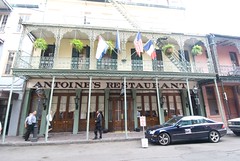Notes from an article published in 07 called "The Threatening Storm,"
By Michael Grunwald.
* Corps officials have also committed to restoring the surge-softening marshes, cypress swamps and barrier islands that are disappearing at a rate of a football field nearly every half-hour. They say they now understand that the survival of New Orleans depends on a sustainable coast.
* traditional engineering: huge structures designed to control rather than preserve nature. And its latest plan seeks to extend those structures along the entire coast, calling for such massive levees across so much of the state that scientists call it the Great Wall of Louisiana. The Corps says it's just an idea, but Congress is about to authorize the first stretch of the wall--a $900 million, 72-mile (116 km) levee.
* "Fix the Coast, or We Are Toast!"
*
NEW ORLEANS WASN'T ALWAYS A CITY IN A bowl. The French founded it in 1718 on high ground along the Mississippi, a "natural levee" of sediment deposited by the river. That's why tourists in the French Quarter stayed dry during Katrina. And that's how all of south Louisiana was built--by the Mississippi River mutinying its banks and rambling around its floodplain like an unruly teenager, dropping mud around its delta and creating roughly 4.5 million acres of wetlands between New Orleans and the Gulf.
So while the French built an earthen levee 1 mile long and 3 ft. high to block the river's annual tantrums, they didn't bother trying to block the occasional hurricanes that swept up the Gulf. "They didn't need hurricane levees," says Kerry St. Pe, a marine biologist whose ancestors arrived in 1760. "They had wetlands to protect them." New Orleans wasn't on the coast, and hurricanes wilt over land.
* After the vast Flood of 1927, the Corps of Engineers built dams, floodways, revetments and pumped-up levees throughout the Mississippi basin, caging the river in its channel, safeguarding riverfront cities, creating a reliable web of liquid highways.
But by walling off the river, trapping its sediments behind giant dams and armoring its erosive banks with concrete, the Corps inadvertently choked off the land-building process. The straitjacketed river now carries less than half its original sediment load down to Louisiana. So there's little new land-building material to offset the natural erosion of the coast, much less the unnatural rising of the sea fueled by global warming.
* The result is that New Orleans is sinking, and about 30% of the coast's wetlands have slipped into the Gulf, jutting Louisiana's chin even further into the path of Mother Nature's fist, endangering the U.S.'s largest offshore oil and gas fields, a lucrative seafood industry, a busy network of ports and about 2 million people.
* "Basically, we found that none of the levees that failed were protected by wetlands or trees," Mashriqui says. Oil and gas canals have accelerated the land losses. But so have Corps navigation canals, especially the notorious Mississippi River Gulf Outlet, a shipping shortcut to the Port of New Orleans that was a larger dirt-moving project than the Panama Canal when it opened in 1965. The canal never carried many ships, but it has carried plenty of saltwater into freshwater marshes and cypress forests, killing nearly 100 sq. mi. (259 sq km) of wetlands.
* The U.S. has no water-resources policy, just a ready-to-build water-resources agency whose agenda is dictated by an annual funding free-for-all among its 535 bosses - the US House of Reps. It's a classic example of Washington's iron triangle: commercial interests lobby the Corps and their Congressmen for projects that supply the Corps with work and political cover and help the Congressmen steer jobs and money to constituents and contributors.
* Scientists believe they know how to save it. They want the Corps to let go of the river in strategic areas so it can get back to work building land, even if that requires rearranging navigation at the mouth of the Mississippi. They want to fill in oil and gas canals, constrict the Gulf Outlet and start pumping sediment back into ridges and barrier islands. The Corps developed $14 billion worth of Louisiana restoration plans before Katrina, but Bush scaled them back to $2 billion. Now the scientists want to think even bigger about the entire ecosystem, even the sediments trapped behind dams 1,000 miles upstream (about 1,600 km).
Subscribe to:
Post Comments (Atom)


No comments:
Post a Comment